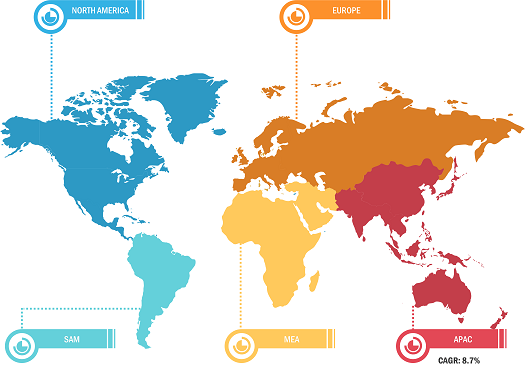Rising Demand from Automotive Industry Supporting Carbon Fiber Market Growth
According to our new research study, titled "Carbon Fiber Market to Forecast 2028 – COVID-19 Impact and Global Analysis – by Raw Material, Application, and End-Use Industry," the market is projected to reach US$ 3,457.74 million in 2022 and is projected to reach US$ 5,605.57 million by 2028; it is expected to register a CAGR of 8.3% from 2022 to 2028.
Carbon fiber is a lightweight and high-strength material composed of thin strands or filaments of carbon atoms. It is made from a precursor material, usually polyacrylonitrile (PAN) or pitch, which undergoes a series of processes such as stabilization, carbonization, and post-treatment to convert it into carbon fiber. Carbon fiber possesses excellent stiffness and rigidity, providing enhanced stability and resistance to deformation. This characteristic makes it suitable for applications requiring structural stability, such as aerospace, automotive, and sports equipment. Carbon fiber is extensively used in the aerospace industry for manufacturing aircraft components, including fuselages, wings, and interior structures. Carbon fiber composites possess remarkable strength and stiffness properties. This allows for the construction of aerospace components that can withstand high-stress loads and vibrations experienced during flight. The exceptional strength of carbon fiber enables the design of lightweight structures without sacrificing strength requirements, improving the overall performance and safety of aircraft. In June 2023, Indian budget airline IndiGo placed a record order for 500 single-aisle, or narrowbody, Airbus aircraft. Thus, the growing aircraft manufacturing industry is driving demand for carbon fiber.
Carbon Fiber Market Breakdown – by Region
Carbon Fiber Market Size and Forecasts (2022 - 2028), Global and Regional Growth Opportunity Analysis
Carbon Fiber Market Size Report | Growth Overview 2028
Download Free Sample
Based on end use industry, the carbon fiber market is segmented into automotive, aerospace & defense, building & construction, sporting goods, wind energy, textiles, marine, and others. In terms of revenue, the automotive segment held the largest share in 2022, and the wind energy segment is expected to register the highest CAGR from 2022 to 2028. The automotive industry is increasingly focused on improving fuel efficiency and reducing emissions. Carbon fiber's high strength-to-weight ratio makes it an ideal material for lightweight vehicles. By incorporating carbon fiber composites into automotive components like body panels, chassis parts, and interior structures, manufacturers can significantly reduce the weight of vehicles, leading to improved fuel efficiency and better performance. Thus, increasing demand from the automotive sector supports the carbon fiber market growth.
As the wind energy sector expands, there is a growing demand for larger wind turbine blades to capture more wind energy and increase electricity generation. Carbon fiber composites offer the necessary combination of strength, stiffness, and lightweight properties to construct these longer blades. Manufacturers can achieve the desired blade length with carbon fiber while maintaining structural integrity and reducing weight, resulting in more efficient and productive wind turbines. The lightweight nature of carbon fiber allows for improved aerodynamic performance of wind turbine blades. Reduced weight reduces the drag on the blades, enabling higher rotational speeds and more efficient energy conversion. Carbon fiber’s stiffness also helps maintain blade shapes and minimizes deflection, optimizing turbine performance. In addition, carbon fiber composites are highly resistant to corrosion, unlike traditional materials like steel. Wind turbines are often installed in offshore environments or coastal areas where they are exposed to saltwater and corrosive elements. By using carbon fiber materials, wind turbine components can have increased resistance to corrosion, resulting in longer lifespans and reduced maintenance requirements. Wind turbine blades are subjected to cyclic loading and fatigue stresses caused by wind gusts and turbulence. Carbon fiber composites have excellent fatigue resistance, enabling them to withstand these dynamic loads over the long service life of wind turbines. These factors are anticipated to drive the carbon fiber market growth.
SGL Carbon SE, DowAksa Advanced Composite Material Industries Ltd Co, Formosa Plastics Corp, Hexcel Corp, Hyosung Advanced Materials Corp, Kureha Corp, Mitsubishi Chemical Corp, Solvay SA, Teijin Ltd, and Toray Industries Inc are among the key players operating in the carbon fiber market. These companies have a diverse geographic presence and offer an extensive product range to cater to consumer trends in the carbon fiber market.
Impact of COVID-19 Pandemic on Carbon Fiber Market
Industries such as automobiles, aerospace & defense, building & construction, and wind energy have been the major contributors to the demand for carbon fiber. In 2020, these industries had to slow down their operations due to disruptions in value chains caused by the shutdown of national and international boundaries. The COVID-19 pandemic hampered the major raw material supply chains and disturbed manufacturing processes due to restrictions imposed by government authorities in various countries. Furthermore, lockdown measures also impacted the availability of laborers, which hampered the production of carbon fiber. Various carbon fiber manufacturers had to temporarily suspend their operations or limit their production capacities, which negatively impacted the carbon fiber market. However, in 2021, economies gradually resumed their operations, which positively affected the global marketplace. As large percentages of people from many countries were completely vaccinated by the end of 2021, manufacturers were permitted to operate at full capacities, which helped them consolidate their efforts toward closing the demand and supply gap. In addition, demand from various end use industries such as aerospace & defense, building & construction, automotive, and wind energy is increasing. These transformations helped them focus on scaling up their production to revive their businesses.
The report segments the carbon fiber market as follows:
Based on raw material, the carbon fiber market is bifurcated into polyacrylonitrile-based and pitch-based. Based on application, the market is segmented into composite materials, microelectrodes, and others. Based on end-use industry, the carbon fiber market is segmented into automotive, aerospace & defense, building & construction, sporting goods, wind energy, textiles, marine, and others. Based on geography, the carbon fiber market is segmented into North America, Europe, Asia Pacific (APAC), the Middle East & Africa (MEA), and South & Central America.
Contact Us
Phone: +1-646-491-9876
Email Id: sales@theinsightpartners.com